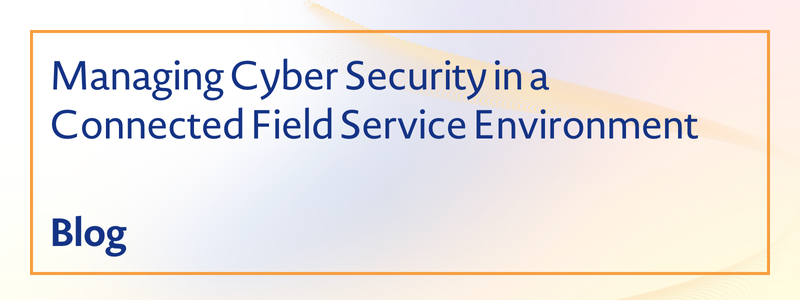Managing Cyber Security in a Connected Field Service Environment


(Source: Pexels)
Field service organizations use a range of technologies to serve their clients. These technologies include software solutions like field service management (FSM) tools, hand-held devices, and IoT-connected products that gather data when operating in the field.
But the adoption of new technologies also comes with inherent risks. In particular, the more connected technologies and software solutions an organization integrates into its workflows, the more openings they create for security breaches.
For example, hackers can exploit vulnerabilities in software to gain access to data systems. Malignant actors can hack IoT devices to launch distributed denial-of-service (DDoS) attacks. Meanwhile, technicians who are on the move can make their personal and company devices vulnerable by linking to unsecured wireless networks, or even by misplacing their devices.
Here are just a few of the ways field service organizations can manage cybersecurity concerns amidst the increasing adoption of new technology.
Create a Culture of Cyber Security Among Your Technicians
When we discuss cyber security issues, we often discuss the inherent risks of hackers and other bad actors attempting to take control of business networks. But often, human error plays a larger role in facilitating the biggest security breaches. For example, so-called "social engineering" attacks like phishing, which take advantage of human vulnerabilities, can result in significant data breaches that cause millions of dollars worth of damage.
For example, according to an article in Infosecurity Magazine, an analysis found that 90% of data breaches in the UK in 2019 were the result of human error. Phishing, "unauthorized access," and hardware or software misconfigurations were some of the biggest culprits.
Ensuring the security of your field service network isn't just a technical task. It's also a cultural one.
To keep your network safe, work to create a culture of cybersecurity within your organization, and especially among your field technicians. Make sure their technologies are updated with the latest patches. You can also create a protocol for maintaining and inventorying company assets, such as handheld connected devices and other technologies, such as AR goggles and portable computing systems.
If your staff manage their passwords, it may be time to centralize your password management process. Use a systematic approach so that passwords are changed regularly, aren't repeated, and are difficult to crack.
When you have staff in the field, make sure they only connect to your network over an encrypted connection. For example, field technicians may be able to access a client's encrypted network instead of relying on publicly available connections that are open.
Secure All Deployed IoT Devices
According to a report by Statista, the total installed base of IoT devices worldwide will amount to 30.9 billion units by 2025. Many of these IoT devices will be embedded in consumer products, but a significant portion of them will integrate with enterprise assets like machines and vehicles.
Keeping all these devices secure from unwanted intrusion will be a monumental task, so it is up to each organization to ensure their IoT-connected devices are protected from hackers and other digital threats.
To accomplish this, organizations must first gain visibility into which IoT devices are connected to their network. Keep a complete inventory of all your company's IoT assets, including their manufacturer, model, and serial numbers, to ensure only intended devices are connected.
You should also adopt standard cybersecurity protocols to protect your network and your devices. This can include network segmentation—the act of dividing a network into subsections to exert more control over them—to reduce vulnerability. Regular patches and updates to your firmware and security platforms are also important.
Finally, be sure to actively always monitor your deployed IoT device. Using a security solution and your regularly updated inventory of devices, you could even create automated alerts when unrecognized devices connect to the network and trigger security response measures.
Work with a Security Partner
Finally, many organizations don't have the bandwidth to hire and manage a wide-ranging cyber security apparatus. Therefore, it may make sense for your organization to partner with security experts regarding your field service operation.
IoT-connected assets can provide significant benefits to your organization but managing their complex lifecycles can be a challenge. With the right partnerships, you can ensure your entire IoT ecosystem is managed effectively and kept secure for both your organization and your clients'.
Learn More About Cybersecurity in Field Service
Cyber security is just one in a long line of challenges facing the field service sector. As organizations continue to mature in their technology deployments, there are exciting innovations on the horizon. Artificial intelligence (AI), machine learning (ML), blockchain, and remote service technologies hold immense promise for field service teams that can use them.
If you'd like to explore these and other field service topics, don't miss the next event from the Field Service conference series. Reserve your spot at the next event right now.